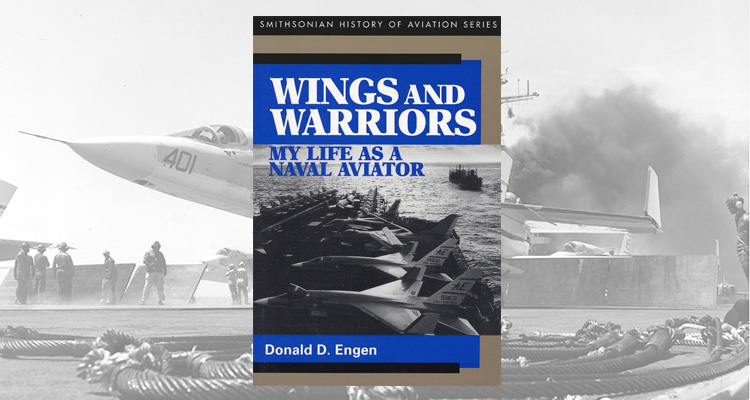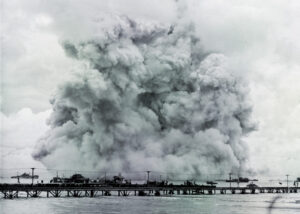Wings and Warriors: My Life as a Naval Aviator, by Donald D. Engen, Smithsonian Institution Press, Washington, D.C., 1997, $29.95.
Thousands of U.S. naval aviators have passed through training courses at Pensacola, Fla., since the first pilot graduated before World War I. Very few, however, have served as test pilots during the difficult transition from propeller-driven planes to supersonic jets for air carrier operations. Don Engen, who retired from the Navy as a vice admiral, is one of those few. Now director of the Smithsonian’s National Air & Space Museum, he previously served on the National Transportation Safety Board (NTSB) and was administrator of the Federal Aviation Administration (FAA) before he held the Air & Space Museum’s Admiral Dewitt Ramsey chair for naval aviation history.
In Engen’s Wings and Warriors, we learn in detail what it was like to be a naval cadet in World War II, flying Stearmans and North American SNJs (the Navy version of the AT-6). The latter trainers were used to practice carrier landings at near-stall speeds, something U.S. Army Air Forces pilot trainees did not have to attempt, to their great relief.
Engen was sent to the Pacific, where he flew scout bombers on combat missions against the Japanese fleet. He left the Navy briefly in 1945 and began flying in the Naval Air Reserve, but he accepted a regular commission in 1946 and began a career that included much flight testing. Engen transitioned to jets in the Lockheed TO-1. He relates the special problems the Navy had in adapting their jets to carrier operations, especially during instrument conditions and at night. The voracious fuel appetites of the jets were a new restraint that naval fliers had to deal with when the Korean War began, but valuable lessons were learned quickly under wartime conditions and rapidly introduced to the fleet. Readers who have never observed carrier operations will find an excellent description of the intricate teamwork required on a carrier’s flight deck during launch and recovery of aircraft–both before and after jets came into widespread use.
Engen was transferred to England in 1953 as an exchange officer to attend the yearlong Empire Test Pilots School at Farnborough, where he flew British jets and participated in tests with the British-designed canted carrier deck. One notable set of tests was with the visual glide slope landing system, using a large, highly polished mirror. Engen says it was “easier to fly than a paddles approach and would be safer at night because it was flown higher.” He particularly liked it “because the pilot flew what he saw and did not have to rely on the judgment of an LSO [landing signal officer].” He also participated in tests with a de Havilland Sea Vampire to see if it could be landed without landing gear on a soft surface. While Engen endorsed the mirror landing system, he recalls that he “was not sure how practical the concept of building airplanes without landing gear would be.”
Engen’s next assignment was to Patuxent, Md., where he experimented with in-flight refueling, personal flying equipment and low-level navigation before returning to the fleet in 1955. Engen later returned to Patuxent and conducted experiments spinning jet fighters, flying a variable stability airplane and making supersonic flights in a hybrid jet/rocket-powered North American FJ-4F. He also tested Air Force jets at Edwards Air Force Base, Calif. He then served stints at sea as commander of a night fighter squadron, an air group and–despite the fact that he was an aviator–the skipper of Mount Katmai, an ammunition ship.
As a captain, Engen was given command of USS America, then the Navy’s newest and largest carrier, which was assigned to the Atlantic fleet. By that time he had witnessed the complete transformation of naval aviation to the point where canted deck carriers could launch four jets per minute. After Engen was promoted to rear admiral in 1969, his subsequent assignments were in the Pentagon and then as deputy commander, U.S. Naval Forces, Europe. His final tour before retirement in 1978 was as deputy commander in chief, U.S. Atlantic Command and U.S. Atlantic Fleet.
What makes this book more interesting than a recital of his assignments is Engen’s interweaving of personal narrative about his family and their adventures as they transferred to bases around the world with him. Most important, he provides myriad details about naval flying during three wars. He admits to a few mistakes and does not make light of the tragedies and special risks connected with naval test flying.
Fortunately for aviation, Engen is now dedicated to preserving aviation’s past for the future at the Air & Space Museum. He is working hard to see that the new museum at Washington’s Dulles International Airport opens before he turns over his last command.





